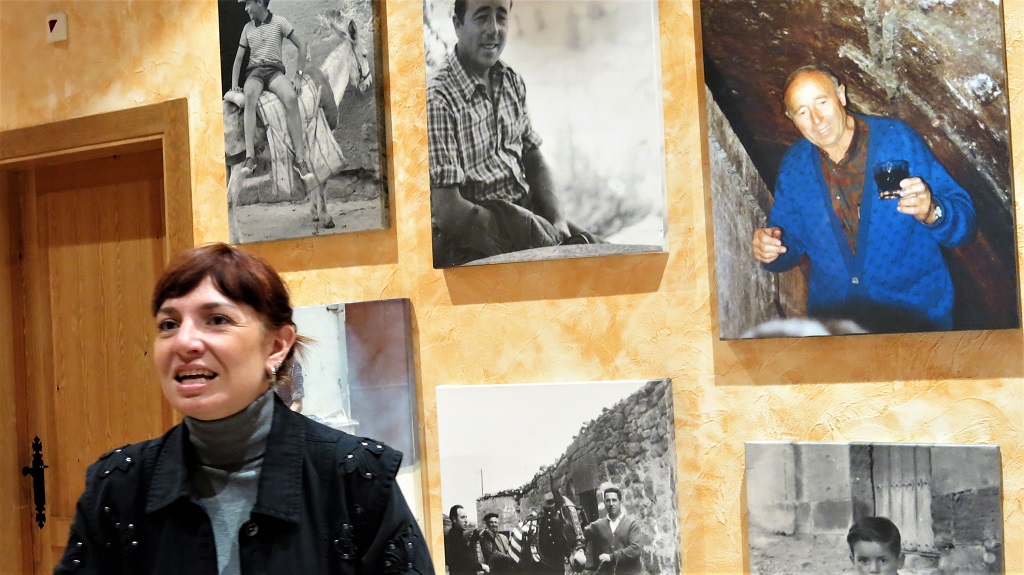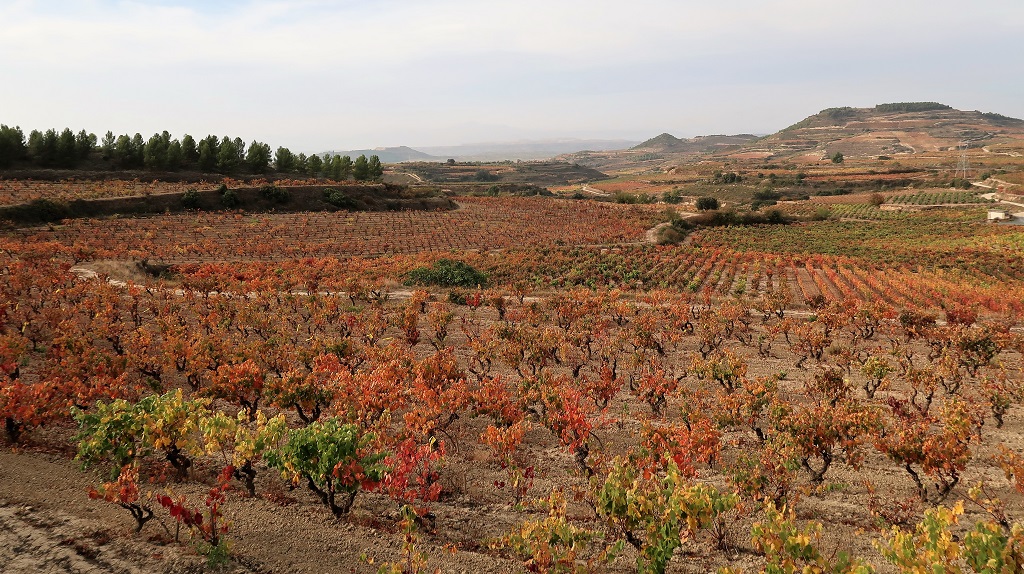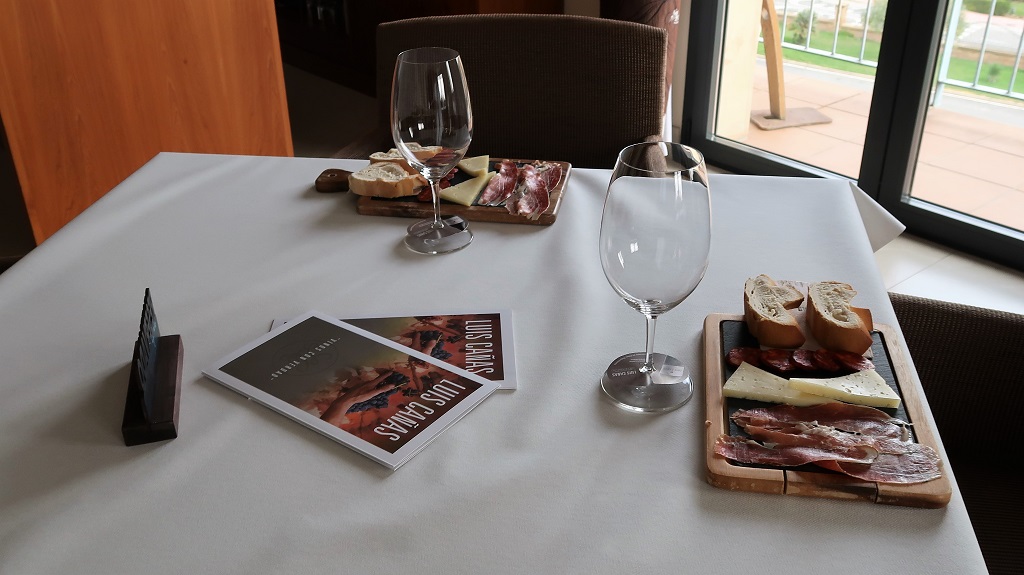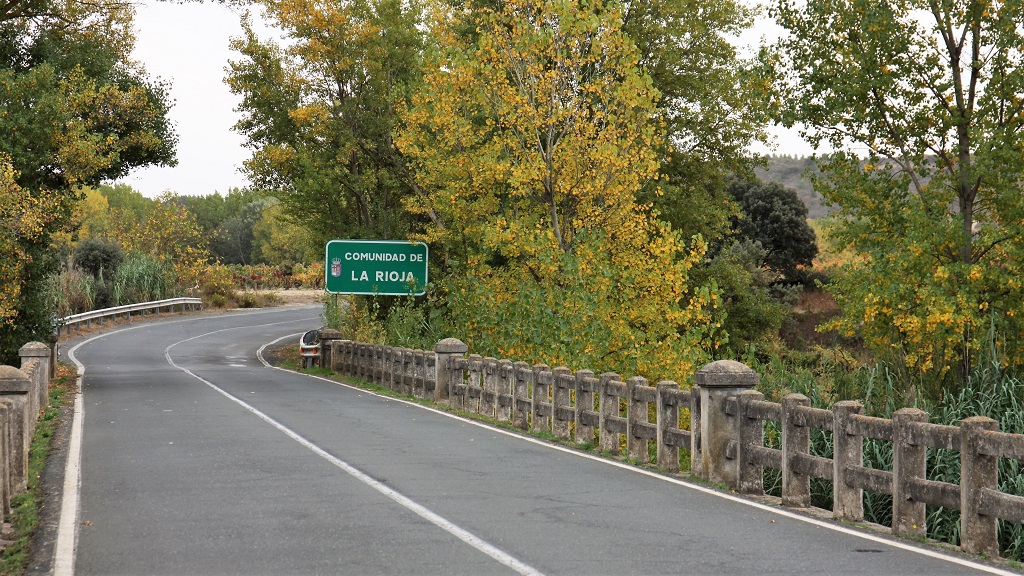The road signs are in the Basque language, Euskara, as well as Spanish. Euskara is always first. Once we crossed the Ebro River, we were in Rioja Alavesa, one of the three sub-regions of DOCa Rioja. This region resides totally in País Vasco.
Before we left the states, Tom was able to coordinate with his friend, a local wine shop owner, and a distributor in Virginia to arrange a Harvest Tour at one of our favorite Rioja wineries - Luis Cañas. Bodegas Luis Cañas is a family-owned winery and has been in business since 1928, which was the year that Carlos Cañas’s son Luis, who is the winery’s namesake was born. Carlos, known throughout the region for his wonderful wines, would load a mule with bladders of wine and cross the Sierra Cantabria and Montes de Vitoria to Bilbao and San Sebastián to deliver his wine to restaurants. Since that time, Bodegas Luis Cañas has gone from a bulk wine house to a modern wine facility and is an example of a successful family operation.
We were really excited about this tour because it would get us into the vineyards that surrounded the winery. We were greeted by Carmen at this upscale wine bar with a wonderful white Rioja, a blend of 90% Viura and 10% Malvasia which had been on the lees for 5 months. We chatted while waiting for our guide Marta. What a great start!
It was only us and a family of three from Miami that would experience the wines and the history of Luis Cañas. Marta joined us and the tour began in front of a large collage of family pictures.
She told us the story of Cañas family and their involvement in the winery. Luis Cañas has handed over the management of the winery to Juan Luis, his son, but remains active in the business. He is well into his 90s. Luis’s grandson Jon has also joined in the operations of the bodega.
The women of the Cañas family were also essential in the development of this family business. The wife of Carlos during the dark years of the 1930s and in the times of Franco put her foot down when Carlos was considering selling and leaving Spain. She said that they would not leave their home in Villabuena as German and Italian planes flew over attacking the Basque Country. Luis’s wife, Ángeles, followed her mother-in-law’s example by putting her heart and soul into the family business assisting her husband in the fields and winery. In 1995, Juan Luis dedicated a wine and started a bodega for his mother because of her passion and love for family and wine. Bodega AMAREN (of my mother) is also in Villabuena not far from Bodegas Luis Cañas. We tell these two stories so that you have a sense of how deep the family is rooted in what they do – and that is make great wine!
Leaving the photo gallery, we went outside to the crush pad, where large containers of pomace were being loaded.
This waste product is sold to make a distilled spirit like grappa that is called Orujo. There was a ton of it… (ha, ha literally) Honestly, there were multiple tons of grape waste product. From the crush pad, the vineyards surrounding the bodega were beautiful. If one looked to the right this was the view…
If you did not like that view, you could look to the left…
We went down below the crush pad to a tasting venue on the edge of the vineyard. Marta opened a lovely 2016 Reserva for us to enjoy while she began talking about the vineyards and the grapes that surrounded us. She explained that after the grapes are picked, the leaves on the vines will begin to change color. A new factoid for the day for us.
The vines in front of us were planted in 1969 and are mixture of Tempranillo (75%), Graciano (20%), and Viura (5%). The grapes in this vineyard are used in one of the bodega single vineyard wines, El Palacio. Fermentation of the three varieties is done together in a French oak and provides a Rioja Alavesa wine reminiscent of days gone by. In front of us was a Graciano vine with the grapes left on the plant for us to see and taste.
The grapes were sweet and very edible, which is not always the case with wine grapes. We enjoyed our outside time, but it was time to move indoors to continue the tour. Finishing up our wine, we passed through an area which is the special sorting area for their Grand Reserva wine. A delivery of new oak barrels had just arrived.
Next stop was a room full of large oak vats that are used fermentation. Some of the vats were still full of the 2022 vintage, but would be transferred soon.
The tour continued as we passed by rows of stainless-steel tanks. Full of juice from this year vintage, the tanks were all connected via an elaborate transfer system. It is a mechanical engineer’s nightmare. Switches, values, and pipes all working together was quite a sight to see.
Following the process of wine making, the next stop was the barrel room, or should I say rooms.
These 225-liter oak barrels can run $800 a barrel and they were everywhere. One could go dizzy trying to count all the barrels in this bodega.
However, the barrels would be much easier to count than the bottles!
Our final stop on our tour was a very special room. It is a very high-end cellar where the family and some of the best customers store their special wines. These special patrons can hold private parties and tastings here. Tom would love to have cubicle with his name on it, but that does not seem likely in this lifetime.
We concluded the visit in a beautiful dining room where tapas and more wine awaited us. We enjoyed both immensely as we chatted with our new friends from Florida.
Saying thank you and goodbye to Marta and our touring friends, we left Luis Cañas totally blown away! The tour was informative, Marta was great, and the wines simply amazing. What an experience!
Crossing back over the Ebro, we continued to chat about everything we had seen and tasted in the last 3 hours. The river was peaceful and the fall colors of the grapevines on the riverbank were spectacular.
The plan of the day called for us to visit a place where a miracle occurred over 800 years ago. Leaving the Basque Country and re-entering into La Rioja, the town of Santo Domingo de la Calzada was programmed into the GPS. We wanted to see where the miracle of the rooster and the hen occurred.
Before leaving for Spain, Janet decided to conquer James Michener’s book, Iberia. Known as an author that no detail escapes his pen, she fought her way through the book. While reading this classic, she encountered the story of the rooster and the hen. When Logroño was added to our trip itinerary, she put rooster and the hen side trip on the list of things to do in Rioja. Arriving at Santo Domingo de la Calzada, we found the small chapel that memorializes the miracle.
Unfortunately, the doors were locked so we just walked the grounds. We read all the signage and peaked into the windows of this small country church. When we walked around back, there was a small fire and a small house. A man was outside working and disappeared quickly at our appearance. There were benches and picnic tables scattered under a small grove of trees. It seemed to be a good place for a respite. We had to wonder if this man, as in the times of Santo Domingo, cared for the pilgrims as they passed through on their Camino, stopping for rest or a bite to eat.
Below is an excerpt from a Camino blog that tells the story of the miracle that Michener also wrote about that stimulated our visit.
As in years gone by, Santo Domingo de la Calzada is still a pit stop for pilgrims on the Camino de Santiago. The miracle seems to be a whopper of tale, but stranger things have happened.
Returning to our apartment, the steps seemed to be getting easier. After a couple hours of respite, we headed out to explore Logroño. The shops were all open and the colors of this flower shop just jumped out as we passed by.
Sunset was around 7:30 and as night took over the day, the city park was an enjoyable place to walk. Families gathered, a group of teenagers were playing ukuleles and singing old folk songs, and children were riding their scooters.
The restaurant we chose was only a block away from the square. We had 8:30 reservations at Wine Fandango. Bet you cannot guess why we chose this restaurant?
Well… if you said it was the only restaurant we could secure a reservation before 10:30, you would be right! We were the first reservation of the night and when we arrived there were a few people outside enjoying cocktails but inside was empty. The restaurant does have an impressive wine selection and they display it at the entrance.
We enjoyed a grilled roasted Turbot, a fish much like a flounder. The fish tasted much better than it looks in the picture. A lovely Rioja Blanco, which came from the owner’s own vineyard, paired very well.
Over dessert, we reflected on the day and were still in awe of the tour and the beauty of Rioja. After a slow walk home, we climbed the steps one more time. Soon after we turned off the lights, sleep came quick. Tomorrow will be another wine day, but we are in Rioja! 😉






























No comments:
Post a Comment